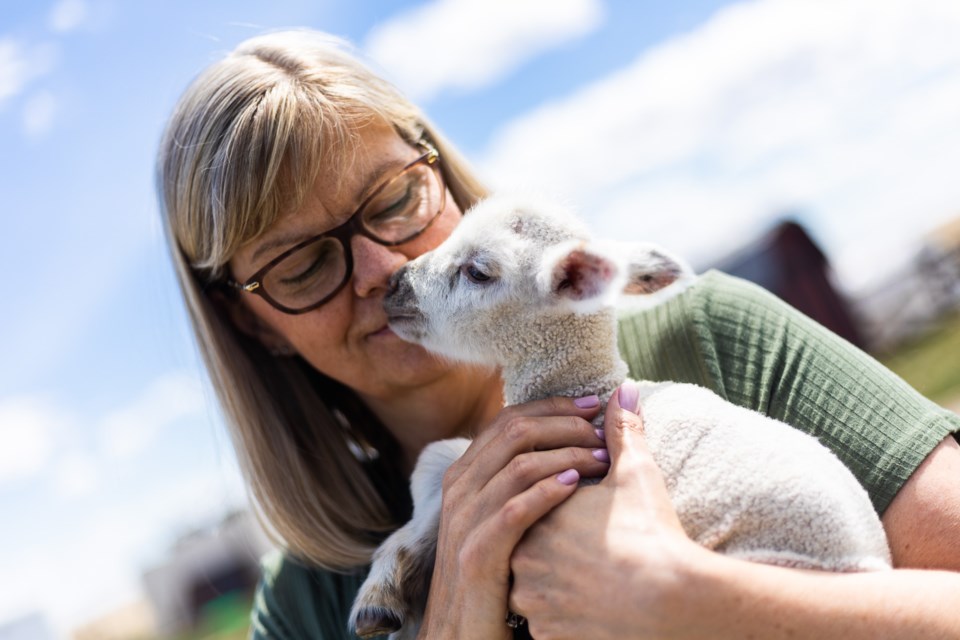When the ewe, affectionately dubbed 'Big Momma' by farmer Catherine Skory, gave birth to six lambs on the morning of May 7, Skory’s own maternal instincts kicked in at the farm west of Cayley.
“I feel joyful. It makes me feel just like when I held my babies,” she said.
While the sextuplets were a surprise, the sheep has had plentiful births in the past.
“We knew this sheep was going to have more than two, she was so big," Skory said.
“Last year she had four, so we were guessing three or four.”
Then labour started and the flock continued to grow.
Skory’s friend and sheep farming partner Hope Collar was in disbelief.
“By three lambs, we had her in the shelter,” Collar said. “Then she started having the lambs and I need to pull that one.”
She saw a fifth lamb emerge.
“I couldn’t believe it, it was so surreal.”
Things started to go sideways for the new gang of siblings when a sixth, the runt of the litter, was discovered.
“She’d had him, but he was still in the sack—I didn’t even realize there was a lamb in there he was so small,” Collar said.
She called Skory to help tend to him, but he was unresponsive and the outlook was bleak.
“My daughter Rachelle was holding him and she felt the life go out of him,” said Skory, who wasn’t ready to give up on the lamb.
“I just instinctively did mouth-to-mouth and he took to it right away. I did it about 10 times and he was back, so we put him under a heat lamp for a while.”
When the mother was unable to care for and feed the lamb, tending to the other five, Skory took him under her wing and named him William.
“He wasn’t going to die under my care if I can help it,” she said. “I took him in the house and he slept in my bed with me the first night.”
She also bottle fed him from birth to get him colostrum, the mother’s first milk which contains crucial antibodies and other bacteria.
“After the first three days, we knew he was gonna make it,” she said.
Two weeks later, Skory said in aninterview that William doing well, albeit still being bottle fed along with one of his siblings for a few weeks to come.
Two are feeding naturally on their mother while another was adopted to different ewe (mother sheep) who accepted it as her own.
Collar, who came into the partnership with a wealth of experience, said in times past, sheep farmers would either not keep runts and orphans, or they would be relegated to solitude to keep them from interfering with the feeding of those born normally.
While they may have been bottle-fed still, a tremendous difference in outcome is seen when the sheep is cared for with more affection or held close, she added, as many newer female shepherds are inclined to do.
This effect is due to the lamb not dealing with a stress response as it starts its life.
“As soon as there’s snuggling, this guy (William) closes his eyes and he gets right under your chin,” Collar said. “That produces endorphins to combat that stress.”
The duo keep 38 ewes, expecting the flock to double as lambing finishes — barring any other plentiful births.
The chances were one in a million that a sheep would have six offspring, said Skory’s veterinarian, Dr. Steven Dillon.
“It’s an extremely rare event to have happen,” he said.
He explained as a sheep grows older, it can release more eggs during ovulation.
A typical birth may have two lambs, with some ewes even birthing three.
There is potential for certain medications to affect how many eggs are released, he pointed out, but in this case, the occurrence was natural.
“That's where we get six live lambs and it was an amazing event,” Dillon added.
While the vet wasn’t called to the farm for the birth, he said Skory’s efforts were “heroic and well educated.
“To know how to look after lambs born in that situation, and even to identify a problem, the fact that she would take that lamb into her own home and look after it."
That all siblings survived with a relatively natural birth amazed him even more.
“I would say it is probably extremely rare given the complications that could have happened during that particular pregnancy or during that particular birth," he said.
“The higher the number of lambs, the higher the chance there’s going to be a complication or entanglement."
In that case a C-section could have been required.
Once on their feet, the lambs may still need human intervention, as an ewe may only be able to provide enough milk for up to three lambs.
The extras, Dillon said, would likely need to be bottle-fed or fostered onto another ewe with a teat to spare or that may have lost her one.
“It just worked out perfectly for all six to be alive after that,” Dillon said.
“All the stars were aligned.”




